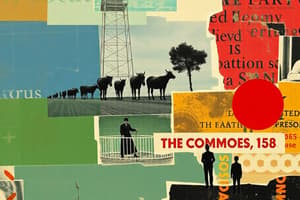Podcast
Questions and Answers
What does the term 'Tragedy of the Commons' primarily describe?
What does the term 'Tragedy of the Commons' primarily describe?
- The benefits of sustainable agriculture
- The danger of private ownership
- The depletion of resources in a capitalist economy
- The conflict between individual interests and the common good (correct)
Overexploitation occurs when resources are used within their capacity to regenerate.
Overexploitation occurs when resources are used within their capacity to regenerate.
False (B)
What is the purpose of cover crops in sustainable agriculture?
What is the purpose of cover crops in sustainable agriculture?
Prevent erosion and retain nutrients during the off-season.
__________ is the maximum resource use that an environment can support without degradation.
__________ is the maximum resource use that an environment can support without degradation.
Match the soil conservation techniques with their benefit:
Match the soil conservation techniques with their benefit:
Which type of irrigation involves flooding a field with water?
Which type of irrigation involves flooding a field with water?
Windbreaks are used to increase soil runoff and increase crop exposure to wind.
Windbreaks are used to increase soil runoff and increase crop exposure to wind.
What is the primary disadvantage of furrow irrigation?
What is the primary disadvantage of furrow irrigation?
Which irrigation method is known for minimal water loss?
Which irrigation method is known for minimal water loss?
Pesticides are always safe for non-target species.
Pesticides are always safe for non-target species.
What is the main goal of Integrated Pest Management (IPM)?
What is the main goal of Integrated Pest Management (IPM)?
The process of removing all trees in an area is called __________.
The process of removing all trees in an area is called __________.
What is a primary disadvantage of surface mining?
What is a primary disadvantage of surface mining?
Salinization is caused by the accumulation of salts in the soil due to excessive irrigation.
Salinization is caused by the accumulation of salts in the soil due to excessive irrigation.
Name one negative effect of abandoned mines.
Name one negative effect of abandoned mines.
Waterlogged soil leads to __________ conditions, which can weaken or kill plants.
Waterlogged soil leads to __________ conditions, which can weaken or kill plants.
Match the type of forest management practice with its description:
Match the type of forest management practice with its description:
Which type of pesticide is designed to target specific pests with minimal unintended harm?
Which type of pesticide is designed to target specific pests with minimal unintended harm?
Flashcards
Tragedy of the Commons
Tragedy of the Commons
Individuals prioritize personal gain from shared resources, leading to resource depletion for everyone.
Carrying Capacity
Carrying Capacity
Maximum resource use an environment can support without degradation.
Sustainable Use
Sustainable Use
Using resources in a way that allows natural replenishment.
Contour Plowing
Contour Plowing
Signup and view all the flashcards
Terracing
Terracing
Signup and view all the flashcards
Windbreaks
Windbreaks
Signup and view all the flashcards
Flood Irrigation
Flood Irrigation
Signup and view all the flashcards
Furrow Irrigation
Furrow Irrigation
Signup and view all the flashcards
Spray Irrigation
Spray Irrigation
Signup and view all the flashcards
Drip Irrigation
Drip Irrigation
Signup and view all the flashcards
Waterlogging
Waterlogging
Signup and view all the flashcards
Salinization
Salinization
Signup and view all the flashcards
What is a pesticide?
What is a pesticide?
Signup and view all the flashcards
What is Monocropping?
What is Monocropping?
Signup and view all the flashcards
What is Pesticide Resistance?
What is Pesticide Resistance?
Signup and view all the flashcards
What is Broad-Spectrum Pesticide?
What is Broad-Spectrum Pesticide?
Signup and view all the flashcards
What is Integrated Pest Management (IPM)?
What is Integrated Pest Management (IPM)?
Signup and view all the flashcards
What is a Biological Control?
What is a Biological Control?
Signup and view all the flashcards
Study Notes
Tragedy of the Commons
- Commons: Shared resources accessible to all. Examples include air, oceans, and forests.
- Carrying Capacity: The maximum resource use an environment can support without degradation.
- Sustainable Use: Using resources in a way that allows for natural replenishment.
- Overexploitation: Using resources beyond their ability to regenerate.
- Tragedy of the Commons: Describes how individuals prioritizing personal gain from shared resources ignores the collective well-being. Analogy: Herdsmen increasing herd size on a shared pasture leading to overgrazing and resource depletion for everyone.
- 2019 US Government Shutdown: Showcased consequences of unregulated shared spaces through misuse of national parks.
Irrigation & Sustainable Agriculture
Soil Conservation Techniques
- Contour Plowing: Plowing along natural land contours to reduce runoff and soil erosion.
- Terracing: Converting slopes into flat steps to allow farming on inclines and reduce water runoff.
- Windbreaks: Planting trees or barriers to reduce wind erosion and protect crops.
- Strip Cropping: Planting alternating rows of different crops to prevent large-scale pest outbreaks and soil erosion.
- Intercropping: Growing multiple crops together as part of crop diversification and soil health.
- Cover Crops: Planting crops that cover the soil instead of for harvest, preventing erosion and maintaining nutrients.
Irrigation Types
- Flood Irrigation: Flooding a field with water, simple and suitable for water-loving crops. High water losses through evaporation, waterlogging, and salinization risks.
- Furrow Irrigation: Water delivered through small channels to crop rows. Inexpensive, better water control, yet 33% water loss to evaporation.
- Spray Irrigation: Water sprayed like rain using sprinklers or pivot systems. Can add fertilizers and time watering, but expensive, uses fossil fuels, and 25% evaporation loss.
- Drip Irrigation: Water delivered directly to plant roots via perforated hoses. Minimal water loss (2-5%), but expensive setup and prone to damage/clogs.
Issues with Over-Irrigation
- Waterlogging: Oversaturated soil creates oxygen-deprived conditions, weakening or killing plants from root rot.
- Salinization: Accumulation of salts in soil due to water evaporation leading to infertile soil.
Pest Control Methods & Integrated Pest Management (IPM)
- Pesticides: Chemicals used to kill or repel pests. (Herbicides, Fungicides, Rodenticides, Insecticides)
- Monocropping: Growing a single crop over large areas, increasing pest susceptibility.
- Pesticide Resistance: Pests develop immunity to pesticides leading to stronger pesticide use. (Pesticide Treadmill Effect).
- Broad-Spectrum Pesticides: Kill many pest species, leading to harming non-target species.
- Narrow-Spectrum Pesticides: Target specific pests.
- Problems with Pesticides: Pesticide resistance, persistent pesticides contaminating the environment, harm to non-target species, biomagnification affecting apex predators.
Integrated Pest Management (IPM):
- Goal: Reduce pesticide use and manage pest populations effectively.
- Biological Controls: Introducing predators of pests.
- Physical Controls: Traps, tilling, screens, or weed blockers.
- Chemical Controls: selective use of pesticides.
- Cultural Practices: Crop rotation, intercropping, pest-resistant crops, and habitat creation for predators.
Mining
- Ore: Material containing valuable minerals (e.g., coal, gold).
- Overburden: Rock and soil above the ore.
- Spoils: Overburden removed during mining.
- Tailings: Leftover material after ore refining.
- Mining Types:
- Surface Mining: Open-pit, strip mining, mountaintop removal, increasing erosion, reducing albedo, disrupting habitats.
- Subsurface Mining: Accessing deep minerals, but expensive and hazardous. Risks include black lung disease, mine collapses.
- Refining Methods:
- Cyanide Heap Leaching: Gold extraction, generates toxic waste.
- Acid Mine Drainage: Sulfuric acid from exposed pyrite contaminates waterways.
- Negative Effects of Abandoned Mines: Increased erosion, water contamination (acid mine drainage), and habitat disruption.
- Mine Remediation: Goal is to restore abandoned mines sustainably using methods like replanting native species for ecological recovery.
Sustainable Forestry
- Sustainable Forestry: Managing forests to balance ecological benefits, economic benefits, and social benefits.
- Clearcutting: Removing all trees in an area.
- Selective Cutting: Removing specific trees to minimize environmental impact.
- Prescribed Burns: Controlled fires to reduce brush and prevent destructive wildfires.
- Forest Services: Ecological services (carbon storage, oxygen production, soil protection, biodiversity support) and economic services (lumber, paper, jobs).
- Harvesting Methods:
- Maximum Sustainable Yield: Harvesting trees at peak growth rate, but can limit mature forests and reduce biodiversity.
- Clearcutting: High yields, efficient replanting, but habitat destruction, erosion, water pollution issues.
- Selective Cutting: Less environmental harm, preserves habitats, more expensive and less efficient.
- Strip/Stand Cutting: Harvest sections while leaving others for regrowth.
- Forest Management Laws: National Forest Management Act (1976): requires sustainable long-term plans for resource extraction, recreation, and habitat conservation.
Studying That Suits You
Use AI to generate personalized quizzes and flashcards to suit your learning preferences.
Description
Explore the concepts of the Tragedy of the Commons, carrying capacity, and sustainable agriculture practices. This quiz examines how shared resources can be mismanaged and the techniques for soil conservation that promote sustainability. Understand the balance between personal gain and collective well-being in resource management.




